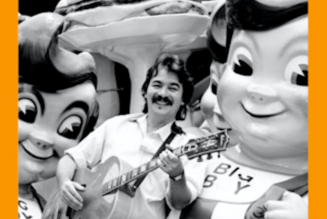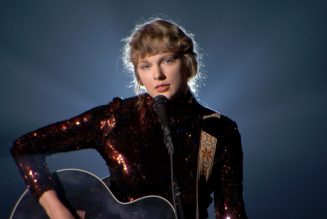From Dua Lipa to Blue Oyster Cult to Joan Jett & The Blackhearts, bands have been figuring out how to perform remotely during the pandemic.
Blue Öyster Cult has played its rampaging-beast classic “Godzilla” 2,270 times, in theaters and casinos, at state fairs and festivals — the first time at the Maple Leaf Gardens, in Toronto, on June 21, 1977, and the last time at Robins Theatre, in Warren, Ohio, on March 8. But until late April, the pioneering hard-rock band’s five members had never done it remotely from their homes, during quarantine, mixed together into a YouTube grid of separate rectangular boxes.
“We basically treated it like a gig,” says Richie Castellano, the band’s guitarist and keyboardist, who produced the “lock-down” version after the band canceled its On Tour Forever tour in March. “You fall into a groove with each other and you’re able to easily get back to this place. It was like riding a bike.”
[embedded content]
Aside from family musicians who live together in self-isolation, bands have been unable to perform while social distancing since concerts shut down in mid-March. So, they have had to get technically creative to create the illusion of performance. Joan Jett and the Blackhearts did “Light of Day” this way in early April; 75 Boston Conservatory at Berklee students went viral with their boxed-in performance of Burt Bacharach‘s “What the World Needs Now” in late March; Dua Lipa performed “Don’t Stop Now” with five backup musicians via video chat on The Late Late Show with James Corden shortly after that; and The Tonight Show with Jimmy Fallon, which regularly splices The Roots into Brady Bunch-style boxes, recently brought in Sting for “Don’t Stand So Close to Me.”
How do bands make these kinds of performances so seamless? Remote-musician software like JamKazam and the Acappella app allow musicians to collaborate live over the internet from separate locations — and Reverb reports that sales of MIDI keyboards, drum machines, microphones and audio interfaces were up dramatically in April, suggesting bands everywhere are trying this. But professional bands prefer the more reliable and polished, if less spontaneous, Blue Öyster Cult approach.
“I’ve seen more than a handful of comments on our YouTube channel: ‘Wow, that’s amazing, how did you guys do that all at once without screwing it up?'” says Steve Schenck, the band’s manager, who estimates they’ve lost several million dollars from canceled tours. “They didn’t. Obviously, that wasn’t live.” Jett and the Blackhearts, with help from their label’s president, Carianne Brinkman, “overcame technical hurdles” to create their performance, says the singer’s longtime manager Kenny Laguna: “I was sure it was not possible to do.”
The easiest way to make these kinds of performances is with access to trained sound engineers and state-of-the-art production software. Shelbie Rassler, a Boston Conservatory at Berklee senior, organized “What the World Needs Now” weeks before her virtual graduation; she made 200 Facebook requests for performances, and when 75 friends responded, she sent them a “mockup” arrangement she made via musical-notation software NotePerformer. Using Rassler’s song sketch, the friends sang or played instruments using smartphones and laptop microphones, then sent tracks back to Rassler, who edited them in Logic Pro X. A mix-engineer friend helped with “making sure all the reverb was correct and EQing every track.”
The musicians also sent video footage to Rassler, who had built rectangular templates via Photoshop. “That was a lot of fitting video into squares and cropping them and making sure the mouth of the person was in time with what they’re singing,” says Rassler, who spent 60 hours on the project. “I’m by no means a video editor, so this was quite an interesting challenge.”
Immediately after bands cut off touring in March, producers at The Late Late Show began sterilizing and shipping cameras, tripods and other equipment to guests’ homes so they could set up remote shoots on their own. The show’s audio engineer, Otto Svoboda, helped the cast of the hit musical Dear Evan Hansen stitch together actors’ remote-at-home performances of “You Will Be Found” in late March. “They filmed themselves super-fast, and our audio producers mixed it,” says Josie Cliff, the show’s supervising producer, adding that Lipa’s team put together “Don’t Stop Now” on their own. “Musicians are creative. They are adapting to this new normal.”
[embedded content]
Blue Öyster Cult’s lockdown “Godzilla” began with drummer Jules Radino, recording himself on Logic playing the band’s usual live arrangement; he sent the files to Castellano, who imported them into Pro Tools. After that, guitarist Buck Dharma laid down his lead guitar and vocals in one take and sent the resulting three files (including iPhone video) to Castellano. Bassist Danny Miranda did the same. Then singer Eric Bloom, whom Castellano calls “not technically inclined, like the rest of us,” recorded his parts using Zoom-like ConnectionOpen software. Finally, Castellano mixed the audio, then used video-editing software Vegas Pro 17 to synchronize the video.
“I know there’s people saying they’re doing it on Zoom. I don’t buy any of that,” Castellano says, by phone from quarantine in Staten Island, N.Y. “Musicians are used to this. It’s overdubbing.”
The members of Hinds took a lower-tech, DIY approach to FaceTime versions of “New for You” and “Come Back and Love Me,” recorded from their respective Madrid, Spain, homes. Singer-guitarist Ana Perrote played along to Hinds’ original Spotify recordings and sent the resulting tracks to singer Carlotta Cosials for mixing.
“We’ve had some fuck-ups in these trial things,” Perotte says. “We record ourselves and we’re alone and you never know what to expect — some we’re super-cheerful, and some we’re a little more serious.”
She adds, “People have asked us, ‘Do you think this is going to be a new way of live shows?’ We hope this is not the deal. It’s fun as a temporary thing, but I miss people. I miss energy. Playing live shows is my favorite part of our job. I really hope to do it again.”










